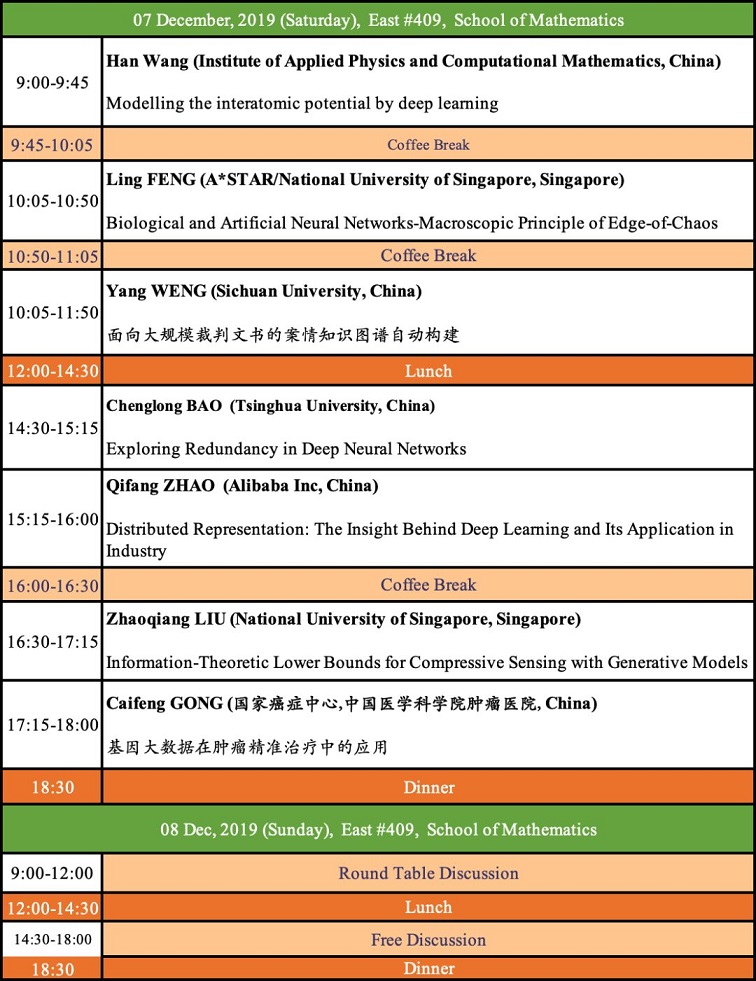通知公告
-
会议议程丨中国法学会网络与信息法学研究会2025年年会暨第三届数字法治大会会议日程
-
授课安排丨四川大学法学院王竹教授授课安排(2025-2026学年秋季学期)
-
报考指南丨四川大学法学院王竹教授2026-2029年博士生报考指南
-
申请指南|数据安全防护与智能治理教育部重点实验室2025年度开放课题申请指南
-
会议议程丨高校哲学社会科学实验室联盟第二届会议
-
详细议程|第四届“数字法治与智慧司法”国际研讨会暨湖北省法学会法理学研究会2024年年会
-
会议议程丨中国法学会网络与信息法学研究会2024年年会暨第二届数字法治大会会议议程
-
会议通知 | 四川省法学会人工智能与大数据法治研究会会员大会暨2024年年会通知
-
征文启事丨CCF中国计算法学研讨会暨第三届学术年会征文启事
-
会议议程丨网络与信息法学学科建设论坛
学术会议丨Deep Learning: Theory, Algorithm and Applications
时间:2019-12-07![]()
· 会议日程 / Agenda ·

· 报告摘要 / Abstract ·
Exploring Redundancy in Deep Neural Networks
报告人:Chenglong BAO (Tsinghua University, China)
The deep neural networks have been widely used in many applications and the classification accuracy increases as the network goes bigger. However, the huge computation and storage have prevented their deployments in resource-limited devices. In this talk, we will first show that there exists redundancy in current CNNs under the PAC framework. Second, we will propose the self-distillation technique that can compress the deep neural networks with dynamic inference.
Biological and Artificial Neural Networks-Macroscopic Principle of Edge-of-Chaos
报告人:Ling FENG (A*STAR/National University of Singapore, Singapore)
The artificial neural networks, in particular deep learning, have been extremely successful in tasks like computer vision and natural language processing. The foundational principle is from neural science, that the network of non-linear interactions is mimicked to enable artificial learning. But such principle is only the microscopic principle of how our brain works. In order for the individual non-linear interactions to work in concert to give rise to ‘intelligence’, the intricate ways that they stacked up with each other play a central role. One of the main ‘macroscopic’ principles found in biological brains is the hypothesis that the whole neural system operates at a critical state between stable and unstable phases, such that it can be the most adaptive and sensitive to a wide range of stimulus. But how about artificial brains like deep neural network? In this talk I am going to talk about our recent finding that indeed an optimal artificial brain operates near this critical state of ‘edge-of-chaos’ like their biological counterpart. But unlike the biological brains which are hard to track and manipulate their individual neurones for theoretical exploration, the artificial neural networks present immense opportunities to carry out in-depth study of their stability behaviours. We found that the deep neural networks evolve to exhibits two opposite forces that induces order and and disorder respectively. At the optimal point, the two forces in the neural network balance out each other to achieve the ‘edge-of-chaos’ state such that highest expressivity is attained.
Information-Theoretic Lower Bounds for Compressive Sensing with Generative Models
报告人:Zhaoqiang LIU (National University of Singapore, Singapore)
The goal of standard compressive sensing is to estimate an unknown vector from linear measurements under the assumption of sparsity in some basis. Recently, it has been shown that significantly fewer measurements may be required if the sparsity assumption is replaced by the assumption that the unknown vector lies near the range of a suitably-chosen generative model. In particular, in (Bora et al., 2017) it was shown that roughly O(k log L) random Gaussian measurements suffice for accurate recovery when the k-input generative model is bounded and L- Lipschitz, and that O(kd log w) measurements suffice for k-input ReLU networks with depth d and width w. We establish corresponding algorithm-independent lower bounds on the sample complexity using tools from minimax statistical analysis and prove that the scaling laws derived in (Bora et al., 2017) are optimal or near-optimal in the absence of further assumptions.
基因大数据在肿瘤精准治疗中的应用
报告人:Caifeng GONG (国家癌症中心,中国医学科学院肿瘤医院, China)
在医疗领域,大数据扮演的角色,就像一个优秀的编辑一样,从各种来源整合信息,比如DNA、蛋白质、细胞代谢产物、组织、器官、有机物和生态系统,通过挖掘其中有价值的内容,不但可以使人工智能系统更好的协助临床医生进行精准的诊断和治疗,而且还能帮助临床对疾病达到全新的认识。肿瘤的治疗更是从经验医学到循证医学,再到如今的精准医学医学,大数据分析为许多医学难题的解决提供了新途径和新思路,改变了疾病的诊疗方式。大数据、人工智能的存在为医生的工作带来了新的手段。基于肿瘤基因的大数据分析,选择优势人群,使得化疗、靶向治疗及免疫治疗的疗效显著升高,提高了肿瘤患者的预后。MSI、TMB、POLE等是免疫治疗的优势人群的筛选因子,均是基于临床循证医学及大数据的分析。通过大数据的积极作用,我们能够更深入的理解人类疾病,对相应疾病个性化诊疗,对医学基础研究和医疗实践的辅助作用将为新时代医学的发展带来新的发展机遇。
Modelling the interatomic potential by deep learning
报告人:Han WANG (Institute of Applied Physics and Computational Mathematics, China)
In silico design of molecules requires an accurate description of the interatomic potential. In the context of molecular simulation, one usually faces the dilemma that the first principle potential energies are accurate but computationally expensive, while the empirical force fields are efficient but of limited accuracy. In this talk, we try to solve this dilemma by using recently developed deep learning and active learning algorithms. We discuss the topic in two aspects: model construction and data generation. In terms of model construction, we introduce the Deep Potential scheme based on a many-body potential and interatomic forces generated by a carefully crafted deep neural network trained with first principle data. We show that the proposed scheme provides an efficient and accurate protocol for a variety of systems, including bulk materials and molecules, and, in particular, for some challenging systems like a high-entropy alloy system. In terms of data generation, we present a new active learning approach named Deep Potential Generator (DP-GEN), which is an iterative procedure including exploration, labeling, and training steps. By the example system of Al-Mg alloys, we demonstrate that DP-GEN can generate uniformly accurate potential energy models with a minimum number of labeled data.
面向大规模裁判文书的案情知识图谱自动构建
报告人:Yang WENG (Sichuan University, China)
以法学知识为中心的认知智能是当前司法人工智能发展的重要方向。本文提出了以自然语言处理(NLP)为核心技术的司法案件案情知识图谱自动构建技术。以预训练模型为基础,对涉及的实体识别和关系抽取这两个NLP基本任务进行了模型设计与优化。针对实体识别任务,采用CRF对基准模型的解码输出层进行改进;针对关系抽取任务,提出融合平移嵌入的多任务联合的语义关系抽取模型,同时获得了结合上下文的案情知识表示学习。以此为基础,本文设计了司法案件的案情知识图谱自动构建流程,实现了对数十万份判决书案情知识图谱的自动构建,为类案精准推送等司法人工智能应用提供语义支撑。
TBA
报告人:Qifang ZHAO (Alibaba Inc, China)
TBA
